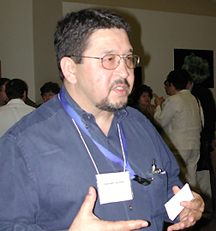
| T H E N I H C A T A L Y S T | M A Y – J U N E 2003 |
|
|
|
NIHerS AMONG ATTENDEES AT TALK URGING RESEARCH ON BIOTERROR COUNTERMEASURESFORMER SOVIET SCIENTIST STRIKES A RESPONSIVE CHORD |
|
 |
|
Ken
Alibeck
|
Ken Alibek, a world-renowned expert on defense against bioterrorism and former Soviet scientist, spoke at the Center for Advanced Research in Biotechnology in Rockville, Md., May 1. His talk was announced over the fellows’ listserv at NIH two weeks earlier and attracted a contingent of individuals from NIH—and from some other governmental agencies, including FDA, DoD, and EPA. Academic institutions and commercial enterprises were also represented among the attendees. Alibek discussed domestic and international bioterrorism, weapons of mass destruction, and homeland defense.
| PROJECT BIOSHIELD |
|
In his 2003 State of the Union address, President George W. Bush introduced the public to a White House initiative called Project BioShield aimed at expediting the development and stockpiling of drugs and vaccines to counter potential bioterror agents. In a talk at NIH several weeks later, Bush specifically mentioned smallpox, anthrax, botulinum toxin, Ebola, and plague—all priority pathogens in NIAID’s Strategic Plan for Biodefense Research—and cited NIH scientists as prime examples of Project BioShield foot soldiers. His call for authorizing legislation was answered in the Senate’s Project BioShield Act of 2003, which names NIAID the lead institute for carrying out the research and development of the necessary biological countermeasures. The bill was reported out of committee and awaits action by the full Senate. In testimony April 4 before the House Government Reform Committee, NIAID Director Anthony Fauci supported Project BioShield for embracing a "new research paradigm" that provides expedited peer review of grants and contracts and streamlined procurement of needed material and human resources to "hasten the pathway from basic research concept to effective countermeasure." He also applauded the provision of funds needed to assure industry of a market for antibioterror products in whose development they invest. |
Some History
In 1969, President Richard Nixon, in a speech at Fort Detrick, ended this country’s biological weapons program and pledged that the United States would never use biological weapons for any reason. (Laboratories housing bioweapons research at Fort Detrick were eventually converted to NCI labs; see "Build It and They Will Come: NCI-Frederick’s Field of Dreams," The NIH Catalyst, July-August 1997.) The USSR, doubting the biological weapons pledge of the United States, continued research into offensive bioweapons, Alibek said.
After graduating from medical school in Kazakhstan in 1975, Alibek, then known as Kanatjan Alibekov, joined Biopreparat, the USSR’s secret bioweapons development program. By 1983, he had become chief scientist and first deputy director of Biopreparat, where he supervised the production of an advanced smallpox weapon.
Alibek visited the United States in 1991 and began to have doubts about the legitimacy of his country’s offensive bioweapons efforts. After the USSR broke up in 1991–1992, he defected to the United States and provided the CIA with information about the USSR’s bioweapons programs. He is currently a distinguished professor of medical microbiology at George Mason University in Fairfax, Va., and executive director of the George Mason University Center for Biodefense.
Asked his opinion about future bioterrorist attacks, Alibek predicted that if they do occur, the most likely agent would again be anthrax—but on a much larger scale than several laced letters and with correspondingly greater psychological, economic, and health effects.
He observed that the anthrax episode—and more recently the SARS outbreaks—touched off fear and panic in the general population that, combined with necessary precautions, nearly shut down parts of society. In Washington, some government buildings were evacuated and remain closed even now; economic consequences linger. A larger- scale attack could have devastating effects, he said.
Alibek stressed that research to develop countermeasures to biological warfare is just as important as training first responders. He advised that the United States devise and test a national biodefense plan and improve its pharmaceutical stockpiles.
Reflections
Like most of the NIH attendees, Steve Tseng, of NCBI and a graduate student in bioinformatics at the Johns Hopkins University in Baltimore, said he was drawn to the talk by general scientific interest and the speaker’s name.
Some others had a more direct connection to the subject matter of the talk.
Cindy Fuchs, a lawyer and technology development manager with NIAID, said she was interested in hearing Alibek’s perspective on the bioterror threat, especially in light of NIAID’s increasing portfolio in biodefense-related research.
Fred Dyda, an investigator in the Laboratory of Molecular Biology, NIDDK, has received a NIAID grant for biodefense research. Dyda’s lab uses tools such as X-ray crystallography to study the molecular mechanisms of protein activity. The additional NIAID funding will be used to apply his research tools to Yersinia pestis, the causative agent of the plague, he said.
Kenneth
Jacobson, chief of the Molecular Recognition Section of the Laboratory
of Bioorganic Chemistry, NIDDK, noted that Alibek’s talk was another
in a series of talks sponsored by the Life Sciences Division of the Jewish Federation
of Greater Washington that he regularly attends. But he was so struck by the
gravity of Alibek’s lecture, he said, that he might consider directing
some of his work—which focuses on G-protein–coupled receptors—towards
bioterrorism defense efforts. ![]()